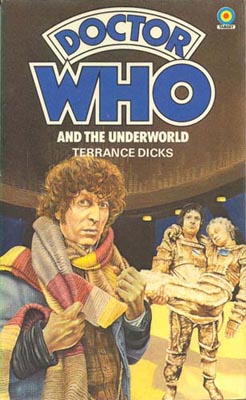Underworld
Doctor Who and the Underworld

|
Underworld |
Target novelisation Doctor Who and the Underworld |

|
| Author | Terrance Dicks |  |
| Published | 1980 | |
| ISBN | 0 426 20068 3 | |
| First Edition Cover | Bill Donohue |
| Back cover blurb: Exploring the very edge of the known universe, the Doctor, Leela and K9 discover a group of astronauts searching for the lost gene bank of Minyan race. During the perilous voyage, the astronauts' craft plunges into the heart of a recently formed planet, wherein an awesome secret is hidden. How will the Minyan quest end? What must the Doctor wrest from the Heart of the Oracle? |
It was a serpent not a dragon... by Tim Roll-Pickering
Terrance Dicks is no Apollonius of Rhodes. And Doctor Who and the Underworld is no Argonautica. The story is heavily inspired by the legends of Jason and the Argonauts, to the point of acknowledging it at the end, but does sometimes make traditional mistakes, such as calling the monster guarding the Fleece a dragon when it was in fact a serpent. However this is a very minor matter and does not detract from a fast-moving book.
In the printed form the reader is spared the excessive use of CSO and instead gets an image of a dark network of tunnels that contain an ever present danger, conjuring up images of a dark scary story. The menace thus becomes ever stronger, but there are several points where the structure of the book is weaker, particularly in the way that it exposes the story as having three neat divisions - the spaceship, the tunnels and the P7E - with few overlaps between them. This makes the story feel very much like a serial of connected pieces. Whilst this approach is not dissimilar to some epics of mythology, it nevertheless fails to work here because the book simply does not aim to be a heroic tale. It taks more than naming characters after Jason (Jackson), Orpheus (Orfe), Hercules (Herrick) and Atalanta (Tala) or randomly talking about trees, quests for golden items to invoke a true sense of awe-inspiring legend, and so we are left with a pale imitation trying desperately to be something it simply isn't cut out to be - not a bad metaphor for much of the Williams' era, it has to be said.
The book opens with a prologue telling the background to the relationship between the Time Lords and the Minyans, how the P7E came to be lost and how Jackson's crew set out to find it, but very little is made of the significance of this. At this point in the series the Doctor is still a wanderer who has opted out of Time Lord society (even though the next story in both transmission and book publication order would move him to be a very central position...) and so it is hard for any burden of guilt to naturally rest on his own shoulders. Thus the prologue is left as little more than a scene setter, and comes across all too easily as pure narration, avoiding the more conventional method of establishing the backstory through dialogue coming at a natural point as the Doctor and Leela (and the reader) slowly discover where the TARDIS has arrived.
There's not much meat at all in this story, either on television or in book form, but Terrance Dicks does make a good effort to keep the narrative flowing and so the book works as a quick read. 5/10